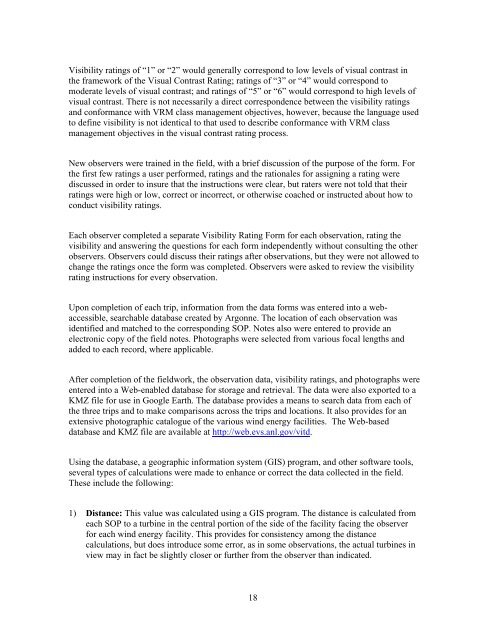Wind Turbine Visibility and Visual Impact Threshold Distances in ...
Wind Turbine Visibility and Visual Impact Threshold Distances in ...
Wind Turbine Visibility and Visual Impact Threshold Distances in ...
You also want an ePaper? Increase the reach of your titles
YUMPU automatically turns print PDFs into web optimized ePapers that Google loves.
<strong>Visibility</strong> rat<strong>in</strong>gs of “1” or “2” would generally correspond to low levels of visual contrast <strong>in</strong><br />
the framework of the <strong>Visual</strong> Contrast Rat<strong>in</strong>g; rat<strong>in</strong>gs of “3” or “4” would correspond to<br />
moderate levels of visual contrast; <strong>and</strong> rat<strong>in</strong>gs of “5” or “6” would correspond to high levels of<br />
visual contrast. There is not necessarily a direct correspondence between the visibility rat<strong>in</strong>gs<br />
<strong>and</strong> conformance with VRM class management objectives, however, because the language used<br />
to def<strong>in</strong>e visibility is not identical to that used to describe conformance with VRM class<br />
management objectives <strong>in</strong> the visual contrast rat<strong>in</strong>g process.<br />
New observers were tra<strong>in</strong>ed <strong>in</strong> the field, with a brief discussion of the purpose of the form. For<br />
the first few rat<strong>in</strong>gs a user performed, rat<strong>in</strong>gs <strong>and</strong> the rationales for assign<strong>in</strong>g a rat<strong>in</strong>g were<br />
discussed <strong>in</strong> order to <strong>in</strong>sure that the <strong>in</strong>structions were clear, but raters were not told that their<br />
rat<strong>in</strong>gs were high or low, correct or <strong>in</strong>correct, or otherwise coached or <strong>in</strong>structed about how to<br />
conduct visibility rat<strong>in</strong>gs.<br />
Each observer completed a separate <strong>Visibility</strong> Rat<strong>in</strong>g Form for each observation, rat<strong>in</strong>g the<br />
visibility <strong>and</strong> answer<strong>in</strong>g the questions for each form <strong>in</strong>dependently without consult<strong>in</strong>g the other<br />
observers. Observers could discuss their rat<strong>in</strong>gs after observations, but they were not allowed to<br />
change the rat<strong>in</strong>gs once the form was completed. Observers were asked to review the visibility<br />
rat<strong>in</strong>g <strong>in</strong>structions for every observation.<br />
Upon completion of each trip, <strong>in</strong>formation from the data forms was entered <strong>in</strong>to a webaccessible,<br />
searchable database created by Argonne. The location of each observation was<br />
identified <strong>and</strong> matched to the correspond<strong>in</strong>g SOP. Notes also were entered to provide an<br />
electronic copy of the field notes. Photographs were selected from various focal lengths <strong>and</strong><br />
added to each record, where applicable.<br />
After completion of the fieldwork, the observation data, visibility rat<strong>in</strong>gs, <strong>and</strong> photographs were<br />
entered <strong>in</strong>to a Web-enabled database for storage <strong>and</strong> retrieval. The data were also exported to a<br />
KMZ file for use <strong>in</strong> Google Earth. The database provides a means to search data from each of<br />
the three trips <strong>and</strong> to make comparisons across the trips <strong>and</strong> locations. It also provides for an<br />
extensive photographic catalogue of the various w<strong>in</strong>d energy facilities. The Web-based<br />
database <strong>and</strong> KMZ file are available at http://web.evs.anl.gov/vitd.<br />
Us<strong>in</strong>g the database, a geographic <strong>in</strong>formation system (GIS) program, <strong>and</strong> other software tools,<br />
several types of calculations were made to enhance or correct the data collected <strong>in</strong> the field.<br />
These <strong>in</strong>clude the follow<strong>in</strong>g:<br />
1) Distance: This value was calculated us<strong>in</strong>g a GIS program. The distance is calculated from<br />
each SOP to a turb<strong>in</strong>e <strong>in</strong> the central portion of the side of the facility fac<strong>in</strong>g the observer<br />
for each w<strong>in</strong>d energy facility. This provides for consistency among the distance<br />
calculations, but does <strong>in</strong>troduce some error, as <strong>in</strong> some observations, the actual turb<strong>in</strong>es <strong>in</strong><br />
view may <strong>in</strong> fact be slightly closer or further from the observer than <strong>in</strong>dicated.<br />
18


